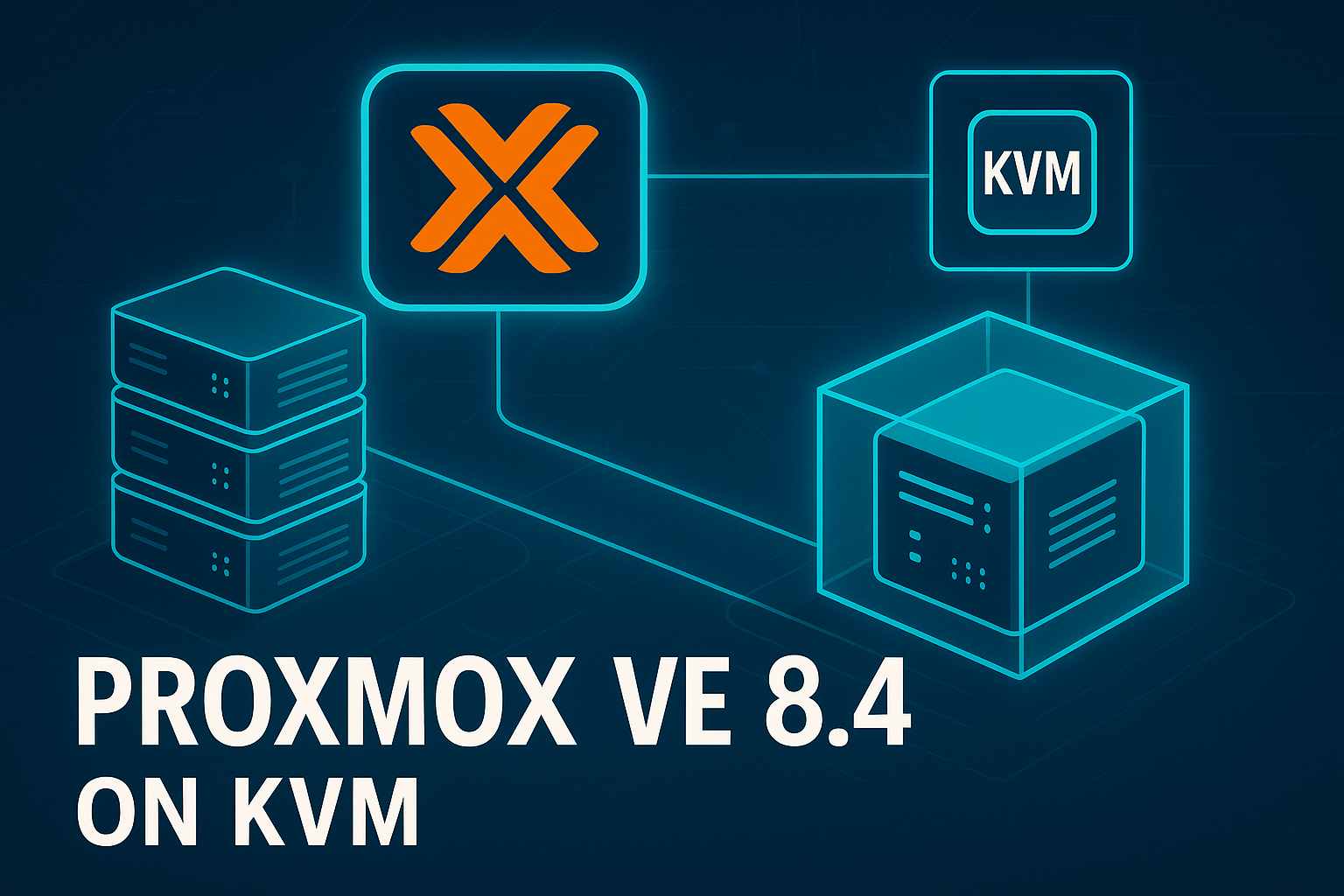Introduction
Proxmox Virtual Environment (VE) 8.4 represents a significant milestone in open-source virtualization, combining the robustness of KVM and LXC technologies with an intuitive web-based management interface. Released in April 2025, this version introduces groundbreaking features like live migration with NVIDIA vGPUs, virtiofs directory passthrough, and an API for third-party backup solutions.
For enterprise architects and DevOps teams, deploying Proxmox VE within a KVM environment offers a powerful sandbox for testing advanced configurations, validating clustering strategies, and prototyping infrastructure changes before production deployment. This guide demonstrates how EC INTELLIGENCE successfully implements nested Proxmox environments for client proof-of-concepts, utilizing Open vSwitch for sophisticated VLAN-aware networking.
Why Virtualize Proxmox?
Running Proxmox VE inside KVM provides several strategic advantages:
- Risk-free testing: Validate clustering, storage configurations, and API integrations without affecting production
- Rapid prototyping: Snapshot and rollback capabilities enable quick iteration
- Training environments: Create isolated labs for team education
- Migration planning: Test upgrade paths and migration strategies safely
- Development sandboxes: Perfect for CI/CD pipeline integration
Prerequisites and System Requirements
Host System Requirements
- CPU: Intel VT-x or AMD-V with nested virtualization support
- RAM: Minimum 16 GB (8 GB for host + 8 GB for Proxmox VM)
- Storage: 200 GB free space for comfortable testing
- Network: Gigabit Ethernet for optimal performance
- OS: Ubuntu 22.04 LTS or newer (tested configuration)
Software Requirements
- KVM/QEMU with libvirt
- Open vSwitch 2.17.0 or newer
- virt-install utility
- Proxmox VE 8.4 ISO
1. Preparing the KVM Host
Enable Nested Virtualization
First, verify and enable nested virtualization on your host:
cat /sys/module/kvm_intel/parameters/nested
# If output is N, enable it:
echo "options kvm-intel nested=Y" | sudo tee /etc/modprobe.d/kvm-intel.conf
# For AMD processors
cat /sys/module/kvm_amd/parameters/nested
# If output is 0, enable it:
echo "options kvm-amd nested=1" | sudo tee /etc/modprobe.d/kvm-amd.conf
# Reload kernel modules
sudo modprobe -r kvm_intel kvm # or kvm_amd for AMD
sudo modprobe kvm_intel kvm # or kvm_amd for AMD
Download Proxmox VE 8.4 ISO
mkdir -p ~/iso
cd ~/iso
# Download latest Proxmox VE 8.4
wget https://enterprise.proxmox.com/iso/proxmox-ve_8.4-1.iso
# Verify checksum (optional but recommended)
wget https://enterprise.proxmox.com/iso/proxmox-ve_8.4-1.iso.sha256
sha256sum -c proxmox-ve_8.4-1.iso.sha256
Install Required Packages
sudo apt update && sudo apt upgrade -y
# Install virtualization stack
sudo apt install -y qemu-kvm libvirt-daemon-system libvirt-clients \
bridge-utils virt-manager virtinst openvswitch-switch
# Add user to libvirt group
sudo usermod -aG libvirt $USER
newgrp libvirt
2. Network Architecture with Open vSwitch

EC INTELLIGENCE's recommended network topology segregates traffic across three logical networks:
| Network Purpose | Bridge Name | VLAN | IP Range | Description |
|---|---|---|---|---|
| Management | management | N/A | 10.10.0.0/16 | |
| Access LAN | s1accessnet | YES | 10.10.100.0/24 | VM guest traffic |
| Cluster | s1clusternet | YES | 10.10.200.0/24 | Corosync, replication |
Create Open vSwitch Bridges
sudo systemctl enable --now openvswitch-switch
sudo ovs-vsctl add-br s1accessnet
sudo ovs-vsctl add-br s1clusternet
sudo ovs-vsctl set bridge s1accessnet vlan-mode=trunk
sudo ovs-vsctl set bridge s1clusternet vlan-mode=trunk
Define libvirt Networks
Create XML definitions for each network:
management.xml (NAT network for management):
<name>management</name>
<forward mode='nat'>
<nat>
<port start='1024' end='65535'/>
</nat>
</forward>
<bridge name='virbr0' stp='on' delay='0'/>
<ip address='10.10.0.1' netmask='255.255.0.0'>
<dhcp>
<range start='10.10.0.100' end='10.10.0.254'/>
</dhcp>
</ip>
</network>
s1accessnet-network.xml (OVS bridge for VM traffic):
<name>s1accessnet</name>
<forward mode='bridge'/>
<bridge name='s1accessnet'/>
<virtualport type='openvswitch'/>
<portgroup name='vlan-all' default='yes'>
<vlan trunk='yes'>
<tag id='10'/>
<tag id='20'/>
<tag id='100'/>
<tag id='200'/>
</vlan>
</portgroup>
</network>
s1clusternet-network.xml (OVS bridge for cluster traffic):
<name>s1clusternet</name>
<forward mode='bridge'/>
<bridge name='s1clusternet'/>
<virtualport type='openvswitch'/>
</network>
Activate the networks:
sudo virsh net-define management.xml
sudo virsh net-define s1accessnet-network.xml
sudo virsh net-define s1clusternet-network.xml
for net in management s1accessnet s1clusternet; do
sudo virsh net-start $net
sudo virsh net-autostart $net
done
3. Deploy Proxmox VE with virt-install
Automated Installation
--disk path=/var/lib/libvirt/images/s1proxmox01.img,size=150 \
--vcpus 8 \
--network network:management \
--network bridge=s1accessnet,mac=52:54:00:20:56:3c,virtualport_type=openvswitch,model=virtio,driver.name=vhost \
--network bridge=s1clusternet,mac=52:54:00:3e:78:dc,virtualport_type=openvswitch,model=virtio,driver.name=vhost \
--console pty,target_type=serial \
--cdrom /home/iso/proxmox-ve_8.4-1.iso \
--graphics vnc,listen=0.0.0.0,port=60200,keymap=fr
Connect to Installation
You can use VNCviewer

4. Proxmox VE Installation Configuration
During the graphical installer, configure:
| Setting | Recommended Value | Notes |
|---|---|---|
| Keyboard Layout | Your locale (e.g., French) | Auto-detected |
| Target Disk | /dev/sda (150 GB) | First disk for OS |
| Filesystem | ZFS (RAID0) | Best for single disk |
| Country/Timezone | Your location | For repository selection |
| Root Password | Strong passphrase | Minimum 8 characters |
| admin@domain.com | For notifications | |
| Management Interface | ens3 (first NIC) | Connected to management network |
| Hostname | s1proxmox01.lab.local | FQDN format |
| IP Address | 10.10.44.10/24 | Static IP recommended |
| Gateway | 10.10.0.1 | libvirt NAT gateway |
| DNS Server | 10.10.0.1 | Can use 8.8.8.8 alternatively |
5. Post-Installation Configuration
Initial System Updates
ssh root@10.10.44.10
cat > /etc/apt/sources.list.d/pve-no-subscription.list << EOF
deb http://download.proxmox.com/debian/pve bookworm pve-no-subscription
EOF
sed -i 's/^deb/#deb/' /etc/apt/sources.list.d/pve-enterprise.list
apt update && apt dist-upgrade -y
Configure Additional Storage
parted /dev/sdb mklabel gpt
parted /dev/sdb mkpart primary 1MiB 100%
# Create LVM thin pool
pvcreate /dev/sdb1
vgcreate vmdata /dev/sdb1
lvcreate -L 180G -T vmdata/thin_pool
# Add to Proxmox storage
pvesm add lvmthin vm-storage \
--vgname vmdata \
--thinpool thin_pool \
--content rootdir,images
Network Configuration for VLANs
Configure VLAN interfaces via web UI or CLI:
cat >> /etc/network/interfaces << EOF
auto ens4.100
iface ens4.100 inet static
address 10.10.100.10/24
vlan-raw-device ens4
auto ens5.200
iface ens5.200 inet static
address 10.10.200.10/24
vlan-raw-device ens5
EOF
systemctl restart networking
